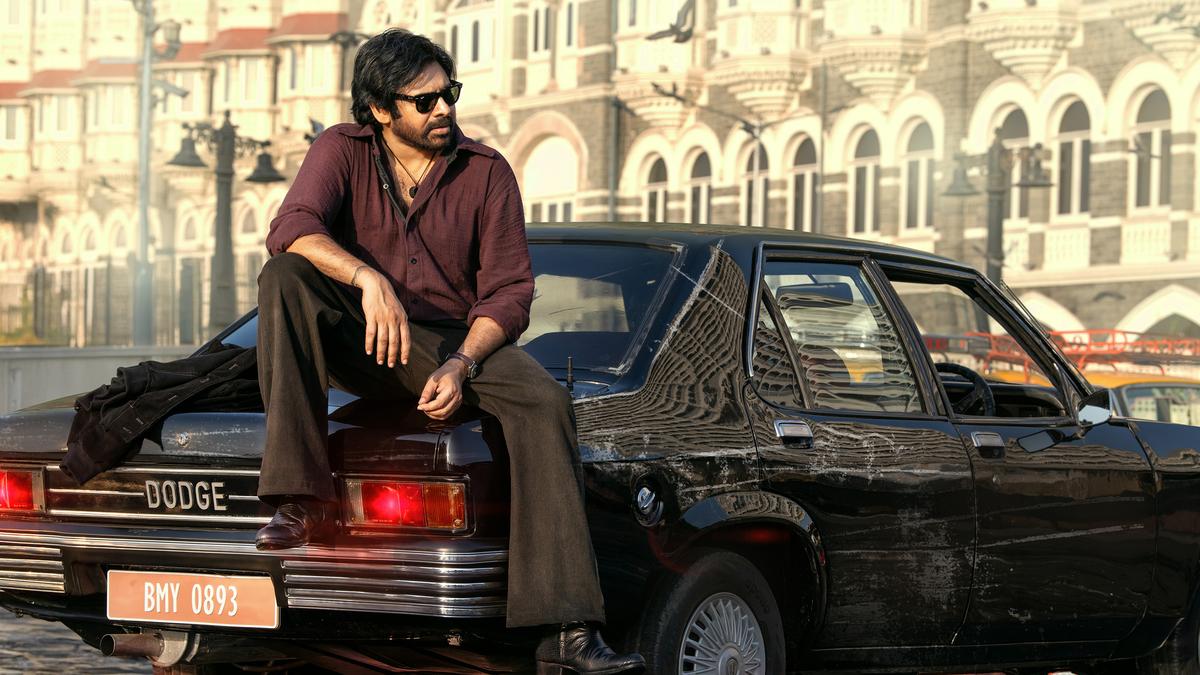“When a cyclone strikes, bow down to the tide. When OG arrives, run and hide.” A character holding a grudge against the protagonist says something to this effect. It isn’t the sharpest mass dialogue in mainstream Telugu cinema, but the actor’s intonation gives it weight. Director Sujeeth’s They Call Him OG references cyclones a few times, but fire serves as the recurring visual motif, shaping the presence of the titular character — Ojas Gambheera, aka Original Gangster, played by Pawan Kalyan. The film was in production for four years, and the director openly acknowledges his admiration for the star, filling the film with fan-service moments.
OG is visually slick, has high-on-energy background score, and the narrative unfolds at a brisk pace that attempts to dissuade the audience from reaching out to their mobile phones. Sujeeth is supported by an efficient technical team that includes cinematographers Ravi K Chandran and Manoj Paramahamsa, production designer AS Prakash, editor Navin Nooli, and music composer S Thaman. Pawan Kalyan, too, looks like he’s had a lot of fun in this action entertainer.
The enjoyment of OG depends on how much the viewer accepts fan-service sequences. The story itself provides little in terms of drama or depth. At its core, it is a familiar gangster narrative: a middle-aged protagonist returns from exile to protect his loved ones and confronts threats to the city. This broad arc has been seen in several recent Indian action films across languages, giving the story a predictable edge despite its polished execution.
They Call Him OG (Telugu)
Director: Sujeeth
Cast: Pawan Kalyan, Priyanka Arul Mohan, Emraan Hashmi, Sriya Reddy, Prakash Raj
Duration: 154 minutes
Story: An original gangster returns from exile to save his dear ones, and the city.
An origin story rooted in Japan adds some novelty to OG, allowing for anime-inspired visuals and action choreography influenced by Aikido and other martial arts. The attention to detail extends even to the font style chosen for certain credits.
Sujeeth leans on his strength in helming stylish action sagas — his previous film being the Prabhas-starrer Saaho. While the story isn’t new, adding more depth and addressing a few plot holes could have helped. The film relies heavily on the larger-than-life hero trope: OG appears just in time to save loved ones, often in ways that demand suspension of disbelief and yet, is not convincing enough.
For most of the film, OG is invincible. Even when he or those close to him are cornered, the narrative does not use these moments to build tension and create empathy for the characters. A subplot referencing the 1993 Mumbai bomb blasts similarly fails to create suspense. Personal loss is included, but predictable — the path to revenge is obvious.
Beneath the action sequences, the story struggles to find footing. The focus is on Pawan Kalyan’s presence, with a colour palette moving from moody greys and browns to brief bursts of brightness during romance scenes. Action sequences rely heavily on visual style, with fire and earthy tones as recurring metaphors.

Sujeeth adds nods to Japanese pop culture and Indian cinema influences — a container named Basanti (Sholay), dialogue from Amitabh Bachchan’s Shahenshah, references to Mani Ratnam and Ram Gopal Varma, and a John Wick-style aesthetic. There is even a fleeting moment hinting at a cinematic universe. Fans of Pawan Kalyan will spot references to his only directorial venture, Johnny. These Easter eggs offer brief enjoyment but cannot compensate for the wafer-thin narrative.
Strip the film off its visual aesthetic and music and there’s very little to appreciate. It’s one thing to marvel at how an introductory action sequence shows splashes of red on a brown surface, without actually focusing on the bloodbath, to imply the brutality, and another to have an entire film relying on style.
Pawan Kalyan dominates the screen, while Prakash Raj, Sriya Reddy, and Arjun Das deliver solid work. Rahul Ravindran surprises in a supporting role, and Priyanka Arul Mohan does what she can within a limited scope. Emraan Hashmi appears lost and disinterested, struggling in an underwritten role and lacklustre Telugu dubbing.
The film could have benefited from more region-specific dialogue to add authenticity. Scenes set in Madurai and Japan use Tamil and Japanese with subtitles effectively; similar treatment for Mumbai gangsters speaking Hindi would have been welcome, especially as audiences are now accustomed to multilingual viewing on digital platforms.
OG aims to tell the story of a Samurai-like hero protecting his people and city, but ultimately, it becomes a film prioritising style and fan service over substance.
(OG is currently running in theatres)
Published – September 25, 2025 03:31 pm IST

